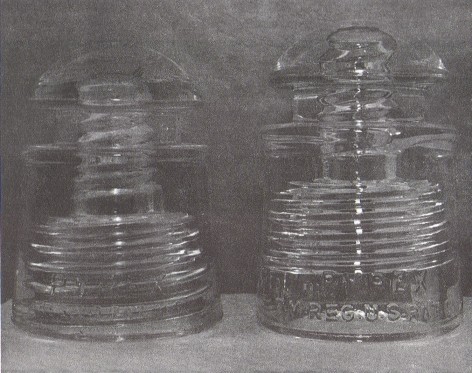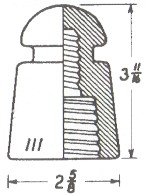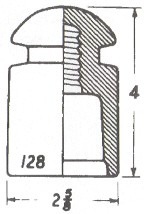Ask Woody
by N. R. Woodward
Reprinted from "Crown Jewels of the Wire", August 1991, page 18
N. R. "Woody" Woodward is the author of The Glass Insulator
in America, 1988 Report and developed
the Consolidated Design Numbers identification system for glass insulators.
QUESTION: Is the smaller Pyrex CD 128 type piece embossed: (F-Skirt)
PYREX/REG. U.S.PAT. OFF the rare CD 111 Pyrex? It is much shorter than the CD
128 style.

 |
 |
|
Comparison scale drawings of CD 111 (left) and CD 128 (right). Scale drawings
of each CD are available in Woodward's THE GLASS INSULATOR IN AMERICA, 1988
Report. (See Reference Library page 58 in this issue) |
As is the case with several CDs, the CD 128 does cover a wide range of
shapes. The insulator (on the left on the previous page) is, I believe, the very
first CD 128 in the Corning line (and therefore, the first since Corning was the
only one to make that CD for many years). I had seen one of those before.
[Insulator on the right is a later and variety with the more standard
dimensions.]
The insulator on the left is not the CD 111,
although the embossing is identical and I suspect they were made at about the
same time. CD 111, although height and base diameter are about the same as your
sample, is more slender, the wire groove is narrower, as is its crown diameter.
The body is not nearly so heavy.
Insofar as I know, at this time the only known
CD 111 is in the museum at Lyons, Colorado, where it was donated by Al
Campbell's widow some years ago. The time I first saw that particular insulator,
some 30 years ago, I was not aware of the other early Pyrex pieces that are in
between the CD 111 and the later, more familiar ones. Had I been, I probably
would not have assigned a new number. But since it has been assigned and
illustrated in print, best to leave it that way.
There is really a great variety in Pyrex CD 128, we have at least two variations of these very early ones
with the very thick skirt and slanting sides. Then when they went into mass
production with the B series, the design was changed and again with the E
series. The N series has the very short spiral of inner threads in the skirt.
Series O through S are a bit different again, then inner skirt ridges were
dropped and we have those extra wide styles (2-3/4" base diameter). Then
finally the last of the line, the 1941 production CSA that is an exact duplicate
of the Hemingray.
| 